Visit the Falkland Islands and you too may be able to capture some incredible photos of the wildlife action on the islands – Caracara, dolphin gulls and a variety of penguin species.

The striated caracara finds a meal to its liking.
Did I really see what I thought I just saw? If this is a question you’ve posed to yourself while out doing photography, then you fully understand that some things in nature don’t make sense–or at least cause you to scratch your head in amazement. Such was the case when I was in the Falkland Islands recently, scouting for a new photo workshop on penguins, albatross, and other birds.
I was working at a rockhopper penguin colony, concentrating on one area, when I heard a commotion behind me. I turned enough to see a striated caracara, one of the few predators found on the various islands where the penguins come to nest and raise their young. The caracara was definitely in a hunting mode as it searched for an evening meal of a young rockhopper, caught on the nest. However, the commotion I heard wasn’t massive numbers of penguins rushing to protect their young. Instead, a pair of dolphin gulls and a Falkland skua were dive-bombing the stalking raptor.
While it would seem more appropriate for the caracara to fly over the colony, select its prey, and then swoop down to grab it, in fact, it was walking around the edge of the colony to locate its target. In the meantime, the gulls and skua were constantly swooping in as determinedly as if they were trying to chase the intruder away from their own nests. Finally, the caracara had enough and flew away–but not too far. After its attackers had also departed, the caracara made a quick return in order to grab a young chick. The defensive attack resumed, but this time the caracara would not be stopped. As it zeroed in on its chosen target, the other penguins spread out, apparently to give the caracara room to grab the small penguin it wanted. However, instead of grabbing the prize and flying away, the caracara dragged it only a few yards before tearing into it. At first, the two gulls and single skua continued dive-bombing, desperately trying to intervene, but they soon gave up when they saw it was too late.
One of the interesting twists in the story was that skuas are also predators of the young penguins on the islands, although they go after only newborn penguins, as they aren’t large or strong enough to get a nestling once it has attained some size.

The striated caracara cowers to protect itself from the dive-bombing Falkland skua.
What added to my bemusement was that while the caracara was picking apart the young rockhopper penguin, the two dolphin gulls landed nearby and watched what was going on. After the caracara had its fill of its meal and left, the gulls came in to finish off the young penguin for their own evening meal. One minute they were trying to chase the caracara away and protect the colony, the next they were enjoying the spoils of the attack. Here’s where I started shaking my head. If they knew they were going to be able to seize the leftovers, why did they try to prevent the killing in the first place?
As I settled into the same area the next evening, I wondered if I might witness a repeat performance. A king cormorant colony with mounds all over the place with adult and young cormorants lay alongside the rockhopper penguin colony. This night, the caracara decided to move in on them. He met with no interference. No skuas. No gulls. I guess the defensive unit didn’t mind if young were taken from the cormorants.
Again, the caracara walked around the edge of the colony to find its target. After picking one out, it just strolled in and grabbed it. However, instead of dragging it away, the caracara sat right there to enjoy its meal. All of the other cormorants within twenty yards of the meal deserted the area, but the parents of the unfortunate victim just sat and watched. Occasionally, a returning cormorant would land at its nest to feed its young, but once it saw what was going on, it would pull up and land with the others that had moved away. After eating all it wanted, the caracara left, and the cormorants came back to their own nest mounds as if nothing had happened.
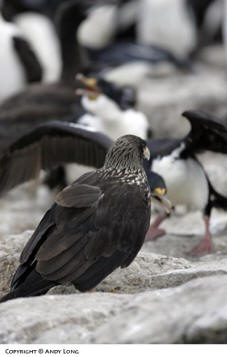
The striated caracara looks over the colony to see which one will be its next meal.
While caracaras will charge in and grab a meal even after the young have grown a bit, once the baby penguins are large enough to move around but not yet able to fish for themselves, the skuas switch gears to get an easy, free dinner. As an adult penguin approaches the colony, having gathered up a stomach full of food to feed its young, the skua uses one of two different tactics: It may try to pounce on the back of the penguin to get it to cough up the food. Or, it may stand nearby as the parent is feeding its young and try to interrupt the feeding, so that some of the food will fall to the ground where the skua can grab it.
There’s no need for a surprise attack or speed for the predators to catch their prey. When a skua hovers over a colony, the adult penguins lift their heads and squawk at it to try to drive it away. It’s quite a sight to see a skua flying just a foot or two above the penguins’ uplifted heads, knowing they can’t jump up or fly to chase it away. Even when a skua or caracara drops down among the victims, there isn’t much the penguins can do to stop the presence, other than yelling or trying to push the offender away by outnumbering it. The predators just casually stroll through the meal line and have their pick of items on the menu. Those entrees along the edges of the colony seem to be preferable, so the diners don’t have to venture into the middle of the colony. The penguins in the middle must have been the first to set up their nests on the ground, perhaps wisely predicting that their young would be the most protected.
For more penguin and other images from the Falkland Islands visit http://www.firstlighttours.com/falklands.html.
Visit the Falkland Islands and you too may be able to capture some incredible photos of the wildlife action on the islands – Caracara, dolphin gulls and a variety of penguin species.
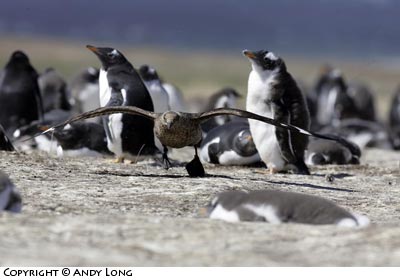
Just like a fox in a henhouse, a skua hangs out in the gentoo penguin colony.

A Falkland skua enjoys the leftovers of the remains left by the caracara.
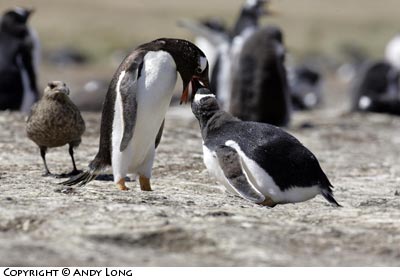
A Falkland skua stands nearby an adult gentoo penguin feeding its young in hopes something falls to the ground.
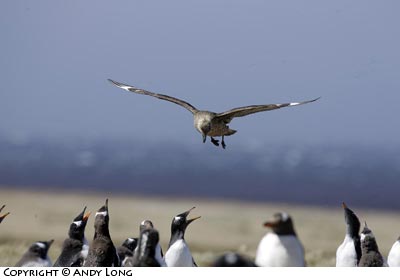
The skua knows its safe just a foot above the gentoo penguins.

You don’t look like my mommy. A skua walks among the king cormorants.
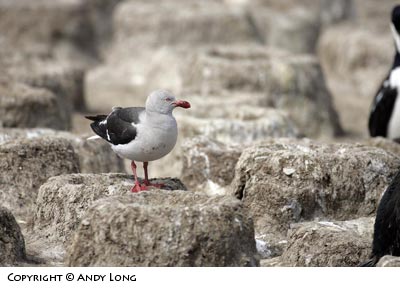
A dolphin gull looks around to see where there might be some scrapes to eat.
By Andy Long

Leave a Reply